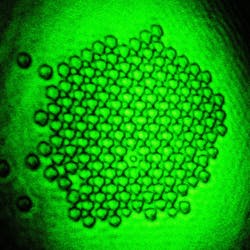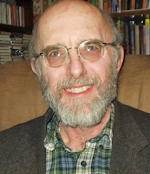Fabrication of an ultra-lightweight mirror by trapping tiny particles with a pair of counter-propagating laser beams has been demonstrated for the first time—nearly 35 years after astronomer Antoine Labeyrie first proposed it in 1979. Labeyrie, now at the College of France (Paris, France), envisioned the concept as a way to build a lightweight mirror in space at a time when work was just starting on the Hubble Space Telescope. Now that astronomers are looking for ways to study more than a thousand planets that have been detected orbiting other stars, it's an idea that sounds particularly intriguing.
Tomasz Grzegorczyk of BAE Systems (Burlington, MA) performed their proof-of-principle experiment on a small scale with Johann Rohner and Jean-Marc Fournier of the Swiss Federal Institute of Technology (Lausanne, Switzerland). The beam illuminated a glass cell containing 3 µm polystyrene beads in water from underneath, with a beam waist of about 40 µm. Scattering of the laser light pushed the beads up and against the top of the glass cell. Meanwhile, a weak gradient force pushed the beads together toward the center of beam, forming a membrane of closely packed particles, they report in the January 17, 2014 Physical Review Letters. The membrane can last for hours, and they have reflected an image in red light from its surface.Their long-term goal is to make seriously large laser-trapped mirrors that weigh almost nothing; for instance, a 35 m mirror weighing only 100 g compared to 850 kg for Hubble's 2.4 m mirror. With suitable optics, light from two ends of a single laser could trap particles to form a giant parabolic mirror in space that could be reshaped without moving large components. The laser and its optics would outweigh the mirror.
"There remain enormous challenges," Grezegorczyk told Science. One is scaling up the mirror size by a factor of a million. Stabilizing the particles in space is another. And that huge mirror will require a whopping big laser.
But gossamer mirrors could ease the problems with big, solid ones. The 6.5 m James Webb Space Telescope, Hubble's successor, must be unfolded in space and its 18 component mirrors positioned with exacting precision. After years of delays, it is now scheduled for a 2018 launch at a cost of some-$8 billion. Three monster ground-based telescopes ranging from 24 to 40 m are planned for completion within a few years of the Webb launch, at costs in the billion-dollar class. Perhaps laser-trapped mirrors can put that class of telescope in orbit at a less astronomical cost.


